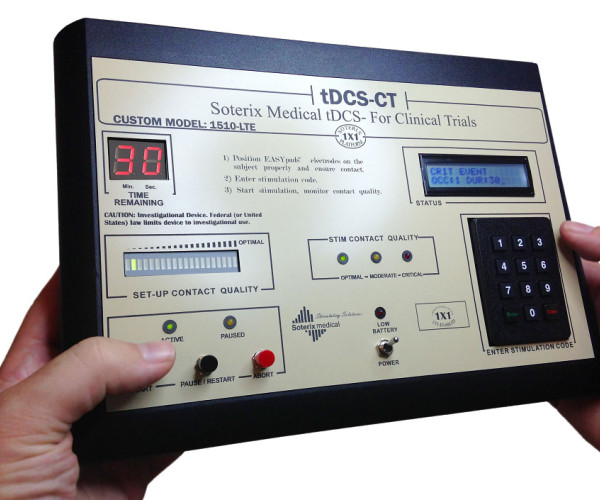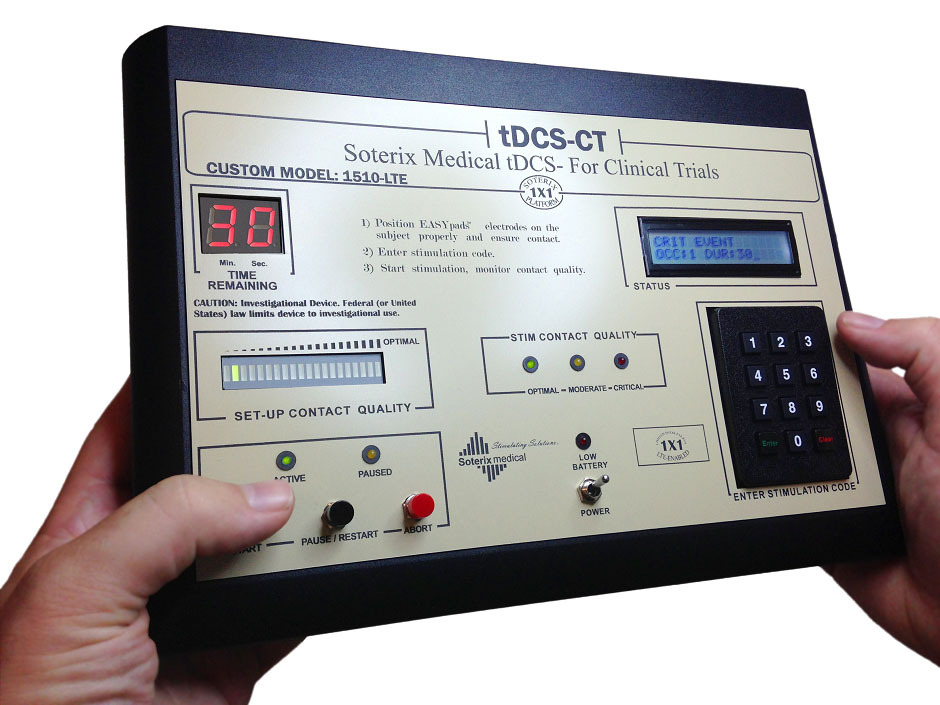
Notice:
Values are in US Dollars for direct import by the end consumer and are subject to import duties and customs duties.
(the amount can be paid in installments or financed - Find out here how to finance)
Transcranial electrical stimulation (tES) for clinical trials. The only true double-blind system, fully programmable and integrated for clinical trials of transcranial electrical stimulation.

True operator blindness
Using basic systems, experienced operators can blind, for example, by observing impedance changes unique to the active arm. The CT interface panel is the only system for true double-blind clinical trials.
True blinding of the subject
The design of the state-of-the-art tDCS study recognizes the limitations of the basic fictitious protocols. CT systems use EASYpad electrodes to decrease the sensation in the active arm and custom ramps to increase the sensation in the simulation.
Reliability
When consistency between oppressors and centers cannot be compromised, each CT system comes with a custom EASYstrap helmet and specific test accessories. Exclusive LTE technology and EASYpads provide constant tolerability.
Avoid Abandonment
In extended testing, dropouts are costly and confuse the results. With features like PAUSE built into custom devices, compliance is increased, saving time, cost and reducing the risk of failure due to lack of statistical power.
Soterix 1 × 1 CT is the most advanced and customizable system for true double-blind control tests
The Soterix Transcranial Direct Current Stimulator Clinical Trials system (1×1-CT) is the most advanced and customizable stimulation for true double-blind control trials. Each 1×1-CT unit is shipped configured for a specific test or test set, including custom accessories and relevant features to ensure the highest standards of reproducibility and safety, all without breaking the subject’s or operator’s view.
In addition, you can count on Soterix Medical’s biomedical engineers and scientists to provide ongoing support for designs and tests.
A Complete System and Process Controls
Soterix Medical 1×1 CT is a complete hardware, software and data management platform for tDCS clinical trials, designed to the highest standard in single, multicenter central clinical trials. Each CT device is programmed for stimulation, quality monitoring and real-time alerts, and data storage based on specific tests. Each clinical trial is supported by Soterix Medical Neurotargeting ™ and the custom helmet design. With SMARTscan-PLUS ™ and an on-board controller automatically managing real and simulated sessions, Soterix Medical 1×1-CT is the only tDCS stimulator that allows true double-blinding from experienced researchers and simple operation by new users. As “one size does not fit all” in rational tDCS therapy and study design, biomedical engineers at Soterix Medical work with clinical researchers to address all technical aspects of tDCS.
DOUBLE BLIND
Fully integrated clinical trial support with customized subject codes and sham protocols
Blind study of clinician and patient for unbiased results.
SMARTscan Plus
Provides a continuous visual indication of the electrode quality before and during stimulation.
From pre-stimulation configuration, during stimulation monitoring, to post-stimulation confirmation, the Soterix Medical SmartScan ™ feature provides an intuitive and clear indication of the quality of the electrode contact. Use SmartScan ™ during setup to adjust the electrodes and main gear for optimal fit. During stimulation, SmartScan ™ provides a constant indication of electrode quality and can be monitored during adjustments (for example, adding saline to the drying electrodes). After stimulation, SmartScan ™ confirms a successful attempt. Since “resistance” is not significant for tDCS, SmartScan ™ was developed by engineers at Soterix Medical to provide clinical investigators with an easy-to-read indication of contact quality.
PAUSE
A simple feature that minimizes dropout in double-blind clinical studies
Sometimes, trivial problems require interruption or adjustment of stimulation. Instead of aborting a session that may result in subject exclusion or data confusion, the PAUSE feature was developed in collaboration with specialists in clinical trials that run trials of greater volume or longer duration. For automatic PAUSE (in SmartScan) and initiated by the user, this exclusive feature intelligently prevents breaking the simulation, even in double-blind tests.
LTE-CT
Limited total energy for clinical trials
A unique feature of Soterix Medical, LTE-CT adapts our proprietary LTE technology to the highest stimulator outputs required in the most advanced clinical trials of tDCS. For current intensities of 2.0 mA and 2.5 mA, LTE-CT provides robustness and safety factors essential for large-scale clinical trials of ETCC. For current intensities> 2.5 mA, contact Soterix Medical.
Reproducible and consistent stimulation configuration
The protocol design and dose optimization are ineffective if the electrodes are not positioned and prepared properly in the field. Using standard or customized EASYstraps ™, each clinical center is provided with a simple to use fixed electrode positioning system. The consistent and reproducible position of the electrode is as simple as attaching to the EASYpads ™ and sliding over the EASYstraps ™ by means of corner rivets to the predetermined position of the electrode. EASYpads ™ are designed to provide reliable current with uniform current density across the skin, using patented corner rivet dispersion and cushion material optimized for consistent saturation and fluid retention. The use of EASYkits ™ further simplifies and homogenizes electrode preparation between operators and locations and eliminates the potential for process replacement.
Soterix Medical developed SMARTscan ™ for its 1×1 systems to facilitate configuration and preparation of the electrode. A simple reading provides an indication of the quality of the electrode contact (Note: reading the device should never replace the operator’s judgment and protocol). For the 1×1-CT system, Soterix Medical developed SMARTscan-PLUS ™ to specifically monitor the quality of the stimulation electrode contact. This new feature is optimized for the assembly of the specific test and can be programmed to prevent the start of stimulation below a quality limit. Experienced users benefit from a quick and consistent setup, facilitated by the easy-to-read display. New users benefit from intuitive setup guidance.
For true operator blindness
Each Soterix Medical CT unit is programmed, validated and shipped directly from the factory with location-specific studies and stimulation codes. These stimulation codes are developed based on the primary investigator’s clinical study plan and can be released, encoded or not, to the study coordinator or statistician. However, for true operator blinding, stimulation codes are just the beginning. For a true blinding of the operator, the operation of the device must be balanced, providing a continuous indication of the stimulation and the quality status of the electrode for safety, without betraying whether the stimulation session is real or simulated.
Blinding Operator for True Sham
Each Soterix Medical CT unit is programmed, validated and shipped directly from the factory with location-specific studies and stimulation codes. These stimulation codes are developed based on the lead investigator’s clinical study plan and can be released, encoded or not, to the study coordinator or statistician. However, for true operator blinding, stimulation codes are just the beginning. For a true blinding of the operator, the operation of the device must be balanced, providing a continuous indication of the stimulation and the quality status of the electrode for safety, without betraying whether the stimulation session is real or simulated. For example, experienced operators will understand what change in electrode impedance is expected during an active tDCS session, since the current flow itself generates characteristic impedance decreases – thus interrupting the blind in conventional stimulators. Likewise, in real conditions, but not simulated, when a fault condition is detected, such as high voltage, requiring corrective action, the shield of the conventional stimulator is broken. The 1×1-CT stimulator provides continuous indication of electrode quality through the exclusive SMARTscan-PLUS ™. After the actual and simulated study protocols are defined, Soterix Medical’s biomedical engineers adjust SMARTscan-PLUS ™ algorithms to provide a simple indication of pacing conditions that is consistent in real and simulated conditions. New operators can count on SmartSCAN-PLUS ™ indicators: “Green” Ideal: Within the defined range; Moderate “Yellow”: Care or attention guaranteed; Critical “Red” (LTE): Outside the defined range. For each test, the operation manual will indicate the necessary corrective steps. Experienced operator will not be able to distinguish between real and simulated sessions. The operator’s true blindness is achieved without compromising object monitoring.
Soterix Medical reports, numbers and images of customized solutions can also be used to improve accuracy in presentations and publications.
Avoid abandoning the subject with PAUSE and LTE
Especially for trials where recruitment is challenging or where multiple sessions with each subject make dropout costly, Soterix Medical PAUSE™ and LTE™ features are enabled in 1×1-CT. For example, pivotal trials often use multi-session stimulation over several days to enhance effects and may even employ a crossover design – in such situations, the need to stop or stop stimulation in a single session can result in costly subject dropout. or confounding of results throughout the analysis. Also, especially in large trials, interruptions in stimulation may occur due to lead quality or subject concerns. Soterix Medical biomedical engineers will work with the study's principal investigators to design hardware and software that
Blind person for true simulation
Because noninvasive brain stimulation, such as ETCC, requires energy to be delivered through the scalp to the brain, the design of appropriate sham controls is critical to reliable clinical trial results. Two complementary approaches can be taken. In the simulated study, the sensation on the skin should be maximized while minimizing the current distribution to the brain. In the real study arm, the sensation should be reduced using the ramp waveform and optimized electrodes, while maintaining the dose of brain stimulation. If the active arm can be reduced to levels where stimulation is imperceptible to most individuals, the simulated arm becomes trivial to project. On the other hand, the electrode waveforms can be designed to increase sensation during the sham arm, without a significant flow of cerebral current. In fact, many of the processes used to reduce sensation during the active arm during full-intensity stimulation can be “reversed” to increase the sensation in the simulated arm, even during weak stimulation. The most direct tDCS simulation includes a temporary activation and deactivation ramp. However, even here there are several permutations, including the rate of ramp increase, the rate of ramp decrease, the maximum ramp intensity (which may or may not correspond to the actual stimulation intensity) and the time and number of ramps. A transient ramp can be applied only at the beginning of the stimulation, only at the beginning or at the end, or at intermittent points (even randomized) during the session. Biomedical engineers and scientists at Soterix Medical are ready to work with you to design the right sham protocol for your study.
Soterix Medical EASYpads ™ are designed to consistently minimize sensation in all subjects, allowing for a reproducible and controlled configuration. Soterix Medical EASYpads ™ is the standard choice for clinical trials of tDCS in one or multiple centers. Soterix Medical SHAMpads ™ are the first tDCS electrodes to include bypass paths embedded in the scalp, which are controlled by the CT stimulator and are blind to the operator. During the active arm, SHAMpads ™ deliver current through functional HD electrode sets, which mimic the current distribution of pad stimulation, but are imperceptible to most conventional tDCS protocols. During the sham arm, SHAMpads ™ shunt current under the electrodes, allowing the reproduction of any level of sensation without a flow of cerebral current. SHAMpads ™ are compatible only with the Soterix Medical 1×1-CT unit and the Soterix Medical HD-tDCS neuromodulation systems.
